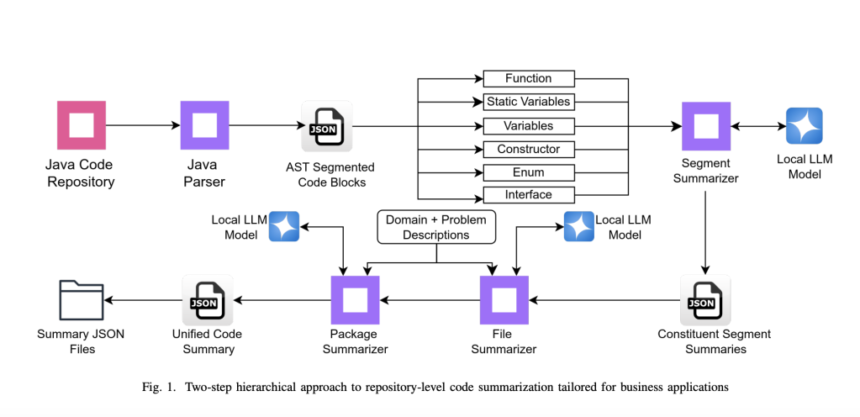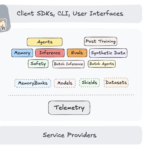

Comprehension and management of large-scale software repositories is a recurring problem in contemporary software development. Although current tools shine when summarizing small code entities such as functions, they struggle to scale to repository-level artifacts such as files and packages. These more abstract summaries are vital for comprehending the intent and behavior of entire codebases, particularly in enterprise applications where technical summaries must be aligned with business goals. According to various reports, this void results in inefficiencies, with developers spending over 50% of their time understanding existing code. These inefficiencies negatively impact productivity and slow down the development and maintenance of systems such as Business Support Systems (BSS) in the telecommunications industry.
Traditional summarization methods, including rule-based and template-driven approaches, fail to meet the requirements of large-scale codebases. While machine learning advancements, such as neural machine translation and transformer-based models, have improved summarization for small code units, they often rely on datasets like CodeSearchNet and CodeXGLUE that focus on system-level code. This narrow focus limits their effectiveness in domain-specific and business-context applications. Code-specific large language models (LLMs), such as CodeLlama and StarCoder, enhance performance but cannot align summaries with broader business intent. Meanwhile, closed-source LLMs, including GPT, offer superior accuracy but raise privacy concerns, making them unsuitable for proprietary enterprise software. These limitations leave a significant gap in repository-level summarization, especially for large-scale applications that require understanding technical details and domain-specific nuances.
Researchers from the TCS Research propose a novel hierarchical framework for summarizing repository-level code, specifically designed for business applications. This strategy aims to overcome the limitations of current practices through local LLM-based privacy preservation and domain-specific grounding for relevance. The process includes dividing large code artifacts into tractable units like functions, variables, and constructors via Abstract Syntax Tree (AST) parsing. Individual segments are summarized separately, and their summaries are then combined into file-level and package-level summations.
A distinctive aspect of this framework is the incorporation of domain-specific and problem-context knowledge through custom prompts. By embedding the summarization process in the telecommunication sector’s business goals and operating environment, the technique ensures that summaries identify the higher-level intent and usefulness of code artifacts. The technique ensures not only that summaries are thorough but also goal-directed in accordance with the purposes of enterprise systems such as BSS, where comprehension of the code’s purpose is as important as its technical nature.
The approach employs AST parsing to identify logical segments from source files, including functions, enums, and variables, which are summarized individually with customized prompts. Functions, for example, are outlined by examining their inputs, outputs, workflows, side effects, and general purpose, while variables and enums are described in terms of their function within the larger application. These summaries at the segment level are aggregated into file-level summaries, which describe the file’s purpose and function within the repository. Likewise, file-level summaries are aggregated into package-level summaries, which give a complete picture of the repository’s structure and functionality. To make the summaries accurate and relevant, the structure includes domain-specific descriptions, including ones about telecommunications and the operating environment of BSS. This grounding enables the summaries to capture not only the technicalities of the code but also the alignment of the code with the overall business objectives, making them very apt for use in enterprise environments.
The researchers evaluated the framework using a publicly available GitHub repository designed to simulate the characteristics of a telecommunications BSS. The hierarchical structure of the summarization process ensured comprehensive coverage of all code segments, resolving the omission issues observed with traditional methods. By systematically summarizing individual components, the approach captured all relevant details, ensuring a complete and accurate representation of the repository. Grounding the summaries in domain-specific and problem-context knowledge significantly enhanced their quality, improving domain relevance by over 7% and completeness by 13%, all while maintaining conciseness and cohesiveness. Performance tests with metrics like ROUGE-L, BLEU, and BERTScore showed significant gains over baseline approaches, reflecting the correctness and context-sensitivity of the summaries. Moreover, professional assessments from the telecommunication sector validated the informativeness and relevance of the produced summaries, affirming their correspondence to business objectives and technical specifications. This holistic approach was especially effective in producing aligned, insightful summaries that meet the particular requirements of enterprise software development.
This hierarchical repository-level code summarization framework represents an important leap forward in the understanding and maintenance of enterprise applications. Through the decomposition of intricate codebases into comprehensible units and the inclusion of domain expertise, the process guarantees accurate, pertinent, and business-focused summaries. It can effectively overcome the shortcomings of current techniques, allowing developers to enhance productivity and simplify maintenance procedures. The technique promises extended applicability in other domains like healthcare and finance, with potential future extensions encompassing multimodal functionality to further enhance code understanding.
Check out the Paper. All credit for this research goes to the researchers of this project. Also, don’t forget to follow us on Twitter and join our Telegram Channel and LinkedIn Group. Don’t Forget to join our 70k+ ML SubReddit.
The post Towards Smarter Code Comprehension: Hierarchical Summarization with Business Relevance appeared first on MarkTechPost.







